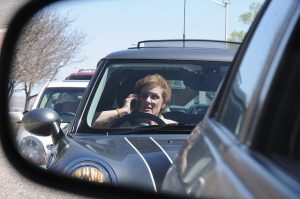 Using your cell phone and driving your car seems like a surefire way to get into some kind of trouble. However, for many people, there is apparently reason enough to take that risk. According to a 2014 study conducted by the National Safety Council (reported on http://stoptextsstopwrecks.org), cell phone use while driving was responsible for 26% of all U.S. car accidents, and California was one of the states with the highest percentage increase.
Using your cell phone and driving your car seems like a surefire way to get into some kind of trouble. However, for many people, there is apparently reason enough to take that risk. According to a 2014 study conducted by the National Safety Council (reported on http://stoptextsstopwrecks.org), cell phone use while driving was responsible for 26% of all U.S. car accidents, and California was one of the states with the highest percentage increase.
Though state laws may have decreased the number of phone conversations, activities like setting up and checking a GPS or navigation APP, or activating a music playlist have actually increased. As a result, there is a nationwide trend to crack down on distracted driving. This has led to many states reviewing their existing laws and also to the creation of a government website called Distraction.gov.
Current California Law
The state of California passed its first cell phone related law in 2006. This law banned the hand-held use of cellphones while driving. Talking on the phone or texting were no longer legal. However, other functions, like the use of a navigation system and even taking a selfie remained unregulated.
- In 2015, DMV.org reported that auto accidents in the state of California, that were attributed to distracted driving, rose an average of 10%.
- In April 2015, police departments in many countries began observations of highway drivers.
- During the month, they found that 13% of the drivers observed were still using cell phones.
- In addition, the number of California drivers in accidents involving cell phones increased over the years to a 2015 high of over 11,000.
All of these results indicated that the existing law was insufficient.
Expanded Law
In September 2016, California Governor Jerry Brown signed assembly bill 1785 into law, to become effective on January 1, 2017. The bill was authored by Democratic Assemblyman, Bill Quirk.
- The new law expands the original, and prescribes that all cell phones must be mounted in a car and that any usage should be hands free.
- The only legal activity is that needing just a single swipe of the finger to complete.
- This law expands the current California vehicle code and states that a driver of a moving vehicle cannot use an electronic wireless communication device to write, send, or read a text based message.
- Devices must be mounted, hands-free, and voice operated, or factory installed in the vehicle.
- Taking photos, streaming video, or programming navigation is now illegal.
- The only exceptions are those driving emergency vehicles during an actual emergency.
- The first violation of this law results in a $20 fine while a $50 fine will be assessed for each subsequent infraction.
There are fourteen states that have laws pertaining to cell phone usage, each hoping to minimize distracted driving. The goal of California’s new law is to reduce the number of traffic accidents due to cell phones. But even if you find the correct mount, and place it in the perfect location in your car, there is no guarantee that using your phone won’t distract you.
Phone videos, FaceTime, Tinder, and many gaming APPS can be activated and maintained with a single swipe so it is easy to legally pay attention to something other than driving. The fines also do not seem steep enough to provide any deterrent and there is no cap on the number of infractions that you can incur. Also, California legislators believe that residents aren’t identifying the high level of risk so part of their goal is education. The message is posted on multiple government communications and hopefully people will begin paying attention.
[Image: https://www.flickr.com/photos/markmorgantrinidad/15591620678/]
Scott Desind
Latest posts by Scott Desind (see all)
- How to Request the County Seat and Fight Your California Traffic Ticket - May 21, 2023
- Don’t Even Touch That Cell Phone - July 13, 2022
- Innocent Until Proven Guilty - March 2, 2020

